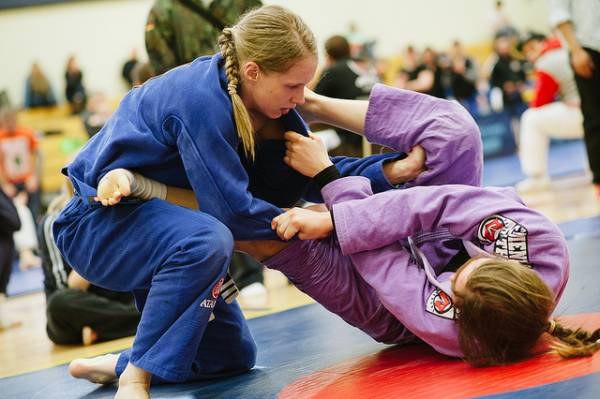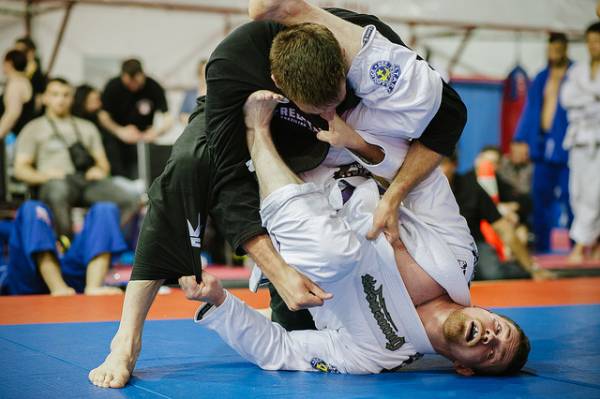In every major sport, a strength coach will spend hours designing programs that are sport and position specific. An offensive lineman and a running back have different requirements based on the position they play. Brazilian jiu jitsu (BJJ) is no different.
Everyone who does BJJ will develop his or her own game. Some may like to play open guard. Others are more of closed guard players. Another group may just want to play top game. Just like in football, some of the skills required to play guard will carry over to playing on top, but the position in which we spend the most time will dictate the needed specific skills, and therefore also the necessary movements for a strength training program.
Closed Guard
BJJ athletes who favor the closed guard will find themselves in constant battles to control posture, position their hips, and grip fight. (Grip fighting is a little different than in open guard, but still important.)
In order to pass your guard your opponent must open it first. The guard passer will normally work to control your hips, which can be done by grabbing your belt or placing the palms near your hipbones. For you to initiate any attack from the closed guard an angle has to be created first. In order to create an angle you must control your opponent’s grips and remove them from your hips.
RELATED: How to Build Grip Strength for BJJ
In most BJJ positions, the body has to work as one coordinated unit. This is particularly true for closed guard. To break someone’s posture, your arms, legs, core, and back must all work together. If you try to break someone’s posture with just your arms or just your legs, it will be very difficult. Consequently, only exercises that allow the body to move as one should be done. Squats, deadlifts, and chin-ups fit in nicely here.
Chin-ups work better than pull-ups for BJJ since the grip on the bar is very similar to the grip used for a choke. During pull-ups the hand is placed in the pronated position. For most of the chokes in the gi the first grip or choking hand is in the supinated position. Chin-ups place the hand in the supinated position, the same position that is required for a cross choke.
Strength and muscular endurance is important to strengthen your BJJ performance. You could find yourself playing closed guard for the majority of a match. Simply keeping the legs closed while playing closed guard will fatigue many athletes.
In closed guard the constant squeezing leads to overdevelopment of the adductors and underdevelopment of the glutes. To develop the strength and endurance that is required to maintain the closed guard position, I recommend a combination of heavy barbell squats and bodyweight movements.
For the closed guard player try the following workout:
- Complete a mobility warm up that focuses on the hips, hamstrings, quads, calves, and thoracic spine.
- Start with box squats. Work your way up to heavy sets of 1-3 reps using 70-90% of your 1-rep max.
- Once you reach a weight that is heavy for 1-3 reps, repeat for 2 or 3 sets. It is best to go down in weight, than miss a rep.
- Rest 2 minutes.
- Next perform 50 reverse lunges with only your bodyweight.
- After all 50 are completed perform 50 bodyweight squats.
- Rest 2 minutes.
- Finally, set a timer for 5 minutes and perform as many strict chin-ups as you can. A good rule is to do 2 or 3 reps every 30 seconds.
This workout will develop muscular endurance and grip strength for the closed guard player.
Open Guard
 For open guard, grips are critical. The fight in open guard is to control grips while the guard passer is trying to break grips.
For open guard, grips are critical. The fight in open guard is to control grips while the guard passer is trying to break grips.
Again the body must work as one, and athletes must remember a good grip requires not just the muscles of the forearms – it is also learning how to activate the latissimus dorsi to lock everything in.
As such, core strength comes into play as well. For an open guard player, I recommend various pull-up and chin-up grips using things like towels or an old gi wrapped around the bar.
Mobility also becomes more important in the open guard. The body can get into some positions where the knee is extended, such as De La Riva guard or spider guard, where one leg needs to be stretched out to create tension while the hand holds a grip. Open guard players should regularly foam roll the following areas: lats, thoracic spine, hamstrings, quads, and calves.
RELATED: What Is a Foam Roller, How Do I Use It, and Why Does It Hurt?
If you are unable to extend your leg fully because of a restriction, you will not be able to generate as much tension as someone who can fully extend his leg. A great way to improve range of motion is to use a doorknob or anything you can grab in front of you. Lower to the bottom of the squat position and try touching your hamstrings to your calves. Start with 1 minutes hold time and work up to 5 minutes.
Since core strength is vital to all BJJ positions, you can follow up that mobility work with some active straight leg raises. Another valuable core exercise is the following open guard movement:
- Lay on your back with your head off the ground and the knees bent 90 degrees.
- While maintaining this position, begin to rock in a circle as if someone was trying to pass your guard and you are trying to keep them in front of you.
- Start with 30 seconds in each direction and work up to one minute.
READ MORE: The Daily Pre-Workout “Tune Up” for Your Race Car (Your Body)
Passing the Guard
 Passing the guard requirements far surpass mere strength and mobility. It also requires speed, lateral movement, and stability.
Passing the guard requirements far surpass mere strength and mobility. It also requires speed, lateral movement, and stability.
Opponents who are experienced in open guard will make passing their guard very difficult. These opponents will place their feet in various positions while stretching or pulling in different directions.
To pass a high-level guard it may take a few minutes. You will have a hard time passing a high-level guard with just one pass. Guard passing requires moving from one pass to the next without sacrificing your base.
Athletes who spend much of a match trying to pass will experience a large buildup of lactic acid in the legs. Standing up in someone’s guard while they are trying to pull you back down is exhausting.
Good guard passers are constantly moving. Lactic acid is a byproduct of anaerobic metabolism. Most of the movements while trying to pass the guard are short and fast. Oxygen is often reduced resulting in a large amount of lactic acid buildup.
To improve guard passing, I recommend single leg movements. Single leg deadlifts with kettlebells work very well. Guard passers also have to be able to move laterally. For lateral movements I recommend using a partner or a training dummy. Place your hands on the knees of your training partner or the training dummy and shuffle side to side while maintaining weight over the knees of your partner. Work up to 3 sets of 1 minute.
LEARN MORE: The 3 Best Single Leg Exercises for Core and Lower Body
The hardest part for many new BJJ students is maintaining balance while trying to pass the guard. This requires developing your proprioceptors, receptors located in your cells that tell your body where it is in space.
Developing proprioception means the body needs to be placed in unstable positions where you have to work to stabilize. A simple drill is placing a cone in front of you, then balancing on one leg and with the same side arm reach and try to touch the cone as many times as possible without losing balance.
ALWAYS WARM UP: Warm Up Drills Can Increase Balance and Proprioception
The further away you are from the cone, the more difficult it is. For an extra challenge, try standing to the side of the cone and reach across your body. This drill improves balance and strength in the knee and ankle joints.
Conclusion
There are fundamental requirements that every Brazilian jiu jitsu player needs – strength, endurance, balance, and flexibility. From there, specific exercises should be included depending on the specific type of game each player uses. Every position requires different types of strength and stability resulting in overdevelopment of some areas and underdevelopment of others.
Programs for the Brazilian jiu jitsu player should focus on strength, correcting imbalances, and specific exercises based on the athlete’s personal game. Having a well-planned program will keep you on the mats for a long time.
Photos provided by David Brown Photography.






